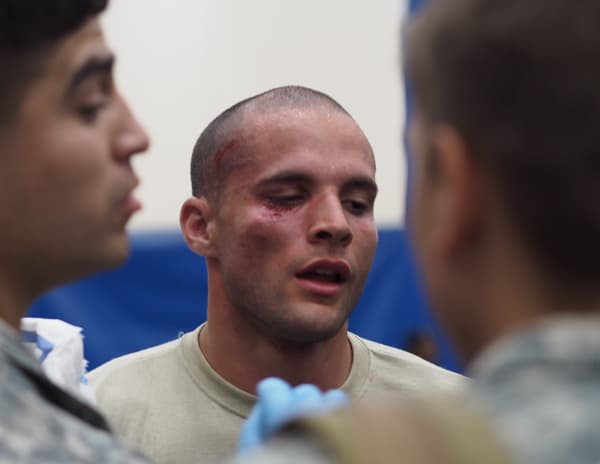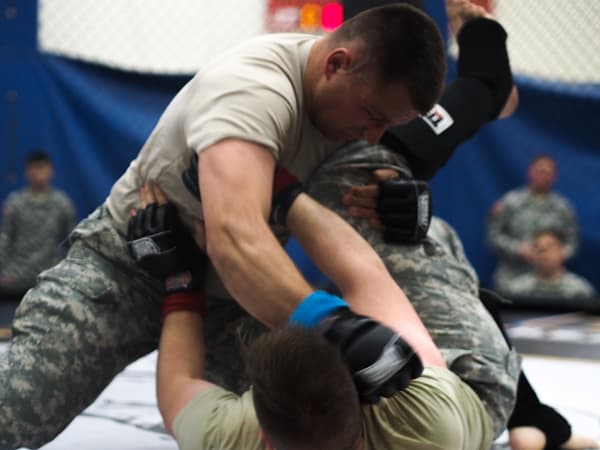Advertisement
Physical Pain, Emotional Healing At U.S. Army 'Combatives' Tournament
Sgt. John Medeiros and I are about the same size, except one of us is covered in muscles and tattoos and the other has on skinny jeans and is holding a tape recorder.
We take ... soldiers that have never been punched in their face before and we punch 'em in the face.
Sgt. Shawn Aronhold, outgoing combatives program director
We're at the back of a gymnasium on Fort Richardson near Anchorage, Alaska, and it's day two of what the U.S. Army stationed here calls its Combatives Tournament. Nearby is the octagonal cage where soldiers have come together to beat each other up. Medeiros is a favorite to win his weight class after several savage victories the day before .
"I got two 'bow-and-arrows,' I got a cross-collar choke and a Kimura with an inverted triangle," Medeiros says to a friend.
The tournament is voluntary. It's a chance for soldiers who want to test their skills with the Army's in-house fighting style, which in military jargon is called the Modern Army Combatives Program, or MACP. But everyone just calls it combatives. Like Krav Maga in the Israeli military and Sambo in Russia, combatives is a hybrid martial art that U.S. Army troops are expected to be proficient in.
A Punch To The Face
Staff Sgt. Matthew Jones asks me, "Would you like to get punched in the face?"
He is the incoming director of the combatives program here at Fort Richardson. And he says the program’s roots stretch back to the '90s, when Army brass heard from troops that their hand-to-hand training was irrelevant and obsolete. Just think of pugil sticks, those giant Q-tips you whack around like boat oars. Those were meant to simulate fighting an enemy with a fixed bayonet.
So, the Army started over.
“We sent some guys to other countries," Jones says. "We went to Brazil, Thailand, Japan. We went to Russia. And we took all those skills and geared it towards a battlefield-ready soldier."
The result is a mash-up that looks, to the untrained eye, like mixed martial arts: some cautious boxing, a few kicks, then a slam to the mat heralding a parade of chokes, arm bars and leg locks. It's serious business.
“There's a lot of soldiers that have PTSD and that like to fight because it helps take their minds off of things that have happened," says Sgt. Shawn Aronhold, the outgoing director of the combatives program on base.
Advertisement
He is huge, by my estimate about three radio reporters wide. The only reason he isn't competing is because of his referee duties, but he's in his element stalking around the octagon wearing sanitary surgical gloves as others spar.
Most matches don't make it beyond the first round, ending in grimace-inducing submissions. One knockout even brings medics scurrying onto the mat.
Combatives programs vary from base to base. Some commanders aren't too enthused and have banned tournaments to keep active-duty soldiers from risking unnecessary injury. That's not the case in Alaska. There’s a required course on the basics of hand-to-hand. And many choose to take more intensive courses.

Combating Stress
"Maybe this is a dumb question, but what's it like to get knocked out?" I ask Aronhold.
"It's actually pretty cool," he replies.
Aronhold is one of the program's most vocal defenders and insists it's far more than just blood sport. In modern war zones, soldiers may be going on house-to-house raids or conducting traffic stops and need to know how to react if things gets physical. That's why instructors practice chokeholds on each other, along with something called an "Option 3 Drill."
"We take people, or soldiers, that have never been punched in their face before and we punch 'em in the face," Aronhold says. "It's not a rite of passage. It's a technique to show, 'Hey, you can get hit in the head or in the body and still be able to perform what you need to do to gain dominance.'"
But most of the guys I talk with say that for them combatives is more about dealing with stress — be it post-traumatic or otherwise.
Not everyone thinks this is a good way to cope, though. Dr. Phillip Baker, a clinical psychologist in Anchorage who works with veterans recovering from trauma, says aggression in the cage may temporarily help depression and stress but does nothing to work through the underlying source.
"I wouldn't recommend it for any individuals who have PTSD," he says. "It does distract you and it does feel good to be physical like that again, but it doesn't help you in the long run get rid of it because it only reinforces those kinds of experiences you've had."
Baker concedes that it may help some as therapy but believes it isn't worth the risks.
"It possibly could be of benefit," he says. "But I — personally, there's so many other ways of fighting that are much more elegant and they're not so dangerous for head injuries or for broken bones and things.”

Teaching Others
Medeiros didn't break any bones, but he did take some hits to the temple and jaw.
He lost his final tournament bout for the middleweight title, but took it in stride, albeit with a slight limp. And unlike Dr. Baker, Medeiros is unequivocal that this helps.
“I don't think I would have made it through a lot of the adversities I have in life if I hadn't built the mental strength that I have through putting myself in some crazy scenarios," Medeiros said. "And I was mentally strong enough to make it through those things because of my history. I don't have time to sit there and dwell on the things that are bothering me in life and stressing me out when my training partners and my coaches are trying to choke me and break my arms."
I asked him about those adversities in his life, but he didn't want to go into details. Now, Medeiros who has trained in wrestling and jiu-jitsu since high school, spends a good deal of his time coaching other fighters, in part to pay forward the help he got early on.
"A top priority right now in the military in general is — there's a lot of suicides going on and people that just feel alone and don't have that outlet for that stress," he said. "But if I can introduce jiu-jitsu and combatives to one person that it's able to help put them in a better place and give them a better outlook on life then I've done something positive."
With the cage nearly dismantled, bags of ice dolled out and zero reporters punched in the face, this year's Combatives Tournament came to a close. Medeiros's plan for celebrating was to eat a giant meal, play with his dog and begin healing for all the fights to come.
This segment aired on July 4, 2015.